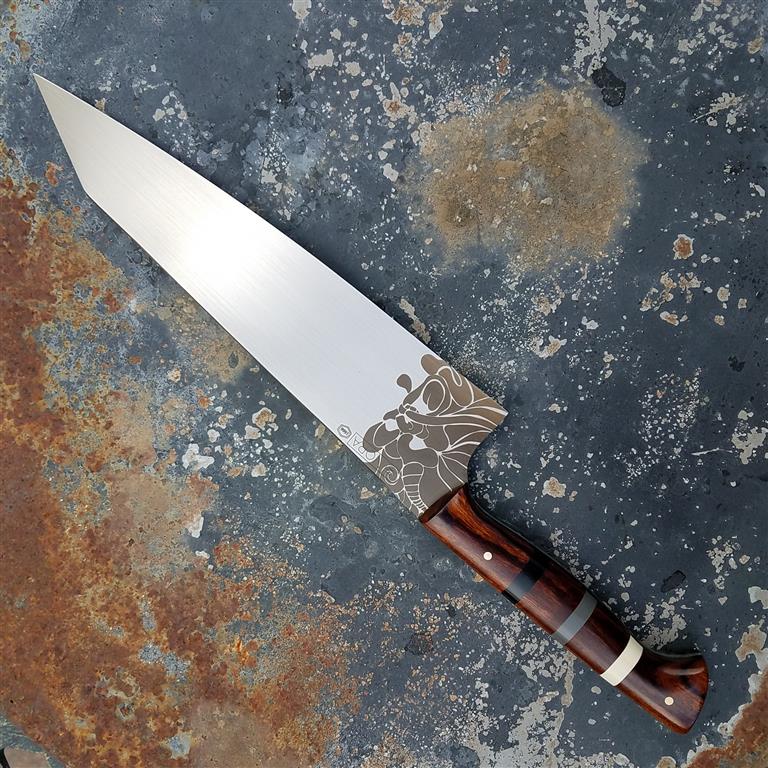
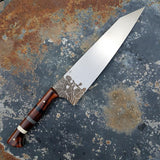
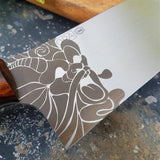
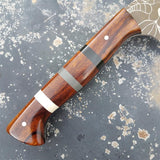
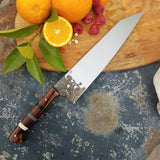
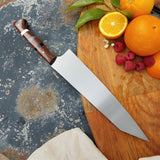


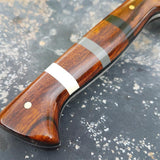
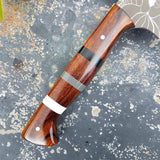
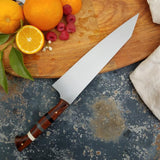
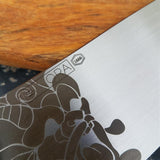
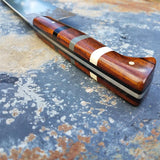
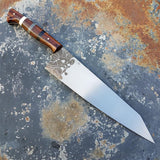
NORA #1666 - 10 Inch Kiritsuke - Rough Beast
$ 521.88
10% of the purchase price of this knife will be donated directly to Matthew 25: Ministries. M25M is an international humanitarian aid and disaster relief organization helping the poorest of the poor locally, nationally and internationally regardless of race, creed or political persuasion. By rescuing and reusing products from major businesses, hospitals and individuals, Matthew 25: Ministries provides basic necessities, skill development and disaster relief across the US and worldwide. They are a 4 start charity, as per Charity Navigator.
KNIFE HIGHLIGHTS
- Blade Type: Kiritsuke
- Blade Length: 10 Inches
- Total Length: 15 Inches
- Handle Style: Western | Right or Left Hand Use
- Steel: AEB-L Stainless Steel
- Handle Materials: Arizona Ironwood, White | Gray | Black G10, Brass Pins, Black G10 Liners
- Rockwell Hardness: 62 HRC
- Grind Type: Full Flat Hybrid - Performance Grind (3 different bevels blended)
- This Blade is Ground...
- Thin for Performance (best performance but delicate)
- Thick for Durability (tough, built to last for heavy wear-n-tear)
- >>> Mid-Range with Special Geometry (specially ground for food release and glide but blade is kept slightly thicker for durability)
- This Knife Feels...
- >>> Heavy in Hand (Hefty. Durable. Handle is on the thicker side as well.)
- Light (nimble, maneuverable)
- Not too heavy, not too light (Switzerland. Fitting weight for the size of the knife.)
GENERAL USES OF THIS KNIFE:
KIRITSUKE KNIFE
This blade shape is our take on the traditional Japanese Kiritsuke knife.
A Kiritsuke knife is one of the very few Japanese knives that is considered multi-purpose. It is a hybrid between a Yanagi (fish slicer) and a Usuba (vegetable knife.). A Kiritsuke knife works well for slicing and breaking down protein but it also excels at vegetable prep. and general purpose tasks. In Japanese kitchens, the Kiritsuke knife is reserved only for the executive Chef as a sign of respect and also due to the skill needed to efficiently use these knives.
Our Kiritsuke design does not have as flat of a belly as the more traditional Japanese style knives. We have done this to allow just the slightest amount of rock in the cut. We feel it adds a bit more versatility to the knife.
ENGRAVING:
Poetry isn't my thing. Usually. There are exceptions though and when I came across The Second Coming by William B. Yeats, it stuck with me. I felt physically uncomfortable reading it. And yet, I read it again. And then once more. I quickly decided I must somehow integrate it into a knife but I've come up blank for so long.
After a lot of searching and failed attempts, the engraving you see was my best effort at bringing to life what I felt reading this poem.
The poem is below:
**This knife has been custom engraved. The engraving was done via a dual diode laser so there is depth to the engraving more so than you usually see with an electro etch or CO2 laser. We do, however, keep the depth relatively minimal so it does not catch food and minimally interferes with the primary cutting function of the knife. A small amount of stickage is normal around the engraved area, especially initially. This will lessen over time as the blade is used. Please note though, if performance is your #1 priority then we encourage you to NOT purchase this blade. A blade with no engraving WILL have a smoother glide than a blade with engraving. For most, however, this difference is minimal. We just like to provide a full disclosure up front so you know exactly what you are purchasing.
The engraving should last as long as the knife itself but please note that it will slightly degrade over time as abrasives are used on the knife. We recommend the soft end of a sponge with soap and water for cleaning and mineral oil periodically to condition the blade (and handle). Keep in mind that stronger abrasives, such as steel wool, scotch brite pads, sand paper or stone sharpening directly on the engraved image will degrade the image over time if continually used.
HANDLE DESIGN & MATERIALS:
Every one of our knives is handmade, unique and numbered. This NORA knife has been handled with an uber-durable Arizona Ironwood that is striped with an equally durable composite: G10. We used three different colors for the G10 including black, white and dark gray. The handle was actually a soft play on "social distancing" due to their even spread and the colors were a nod to the theme of light and dark that is present in the engraving/poem. I'm not sure if it all worked out but it sure sounded good at the time I designed it.
So what is G10? G10 is an incredibly strong & durable fiberglass laminate that was originally used in the electronics industry. It has been adapted in the knife making world and has proven to be an excellent material for handles as it has high strength, low moisture absorption and can be found in a variety of colors. It’s one of our favorite materials to work with outside of wood. In this case, we thought it was a beautiful complement with the wood.
STEEL INFORMATION:
AEB-L STAINLESS STEEL
This knife blade is composed of AEB-L stainless steel which is a high-quality Swedish metal, originally developed for razor blades. Recently, steel suppliers have made this steel available in thicker sheets and it has proven to be an excellent adaptation for the cutlery industry.
AEB-L has a beautiful balance of carbon and chromium and, with proper heat treatment, this steel produces both a very fine edge as well as excellent toughness and edge stability. The fine grain structure also makes this steel very easy to sharpen. We believe it is one of the finest stainless steels available on the market today for use with kitchen knives.
As a side note, there are two things we like to mention about this steel:
1.) This steel responds beautifully to honing and if the knife is honed regularly it should need infrequent sharpening.
2.) AEB-L is a stainless steel but just barely. The higher carbon content in this stainless is what allows it to get a fine edge and higher hardness than other stainless steels but it also has a tendency to sometimes form very fine rust spots on the blade. If this happens, these are easily removed with a green scotch brite pad and usually the rough end of a kitchen sponge will also do the trick.
